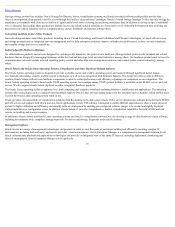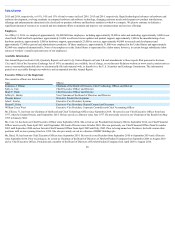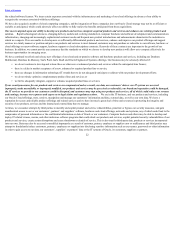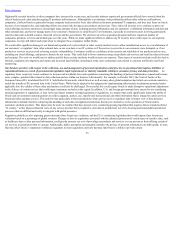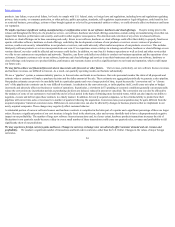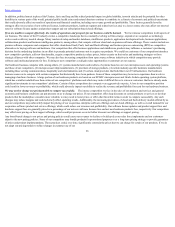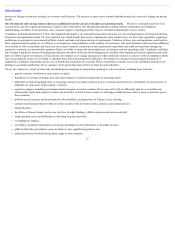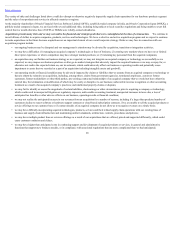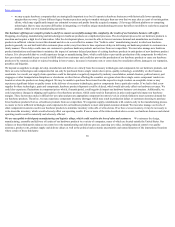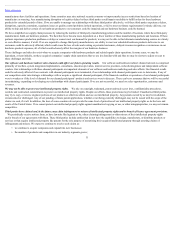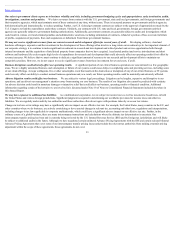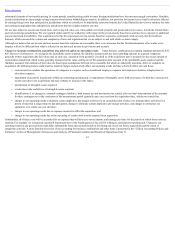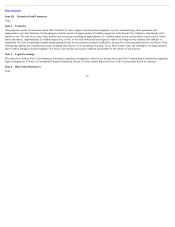Oracle 2015 Annual Report Download - page 28
Download and view the complete annual report
Please find page 28 of the 2015 Oracle annual report below. You can navigate through the pages in the report by either clicking on the pages listed below, or by using the keyword search tool below to find specific information within the annual report.
Table of Contents
In addition, political unrest in places like Ukraine, Syria and Iraq and the related potential impact on global stability, terrorist attacks and the potential for other
hostilities in various parts of the world, potential public health crises and natural disasters continue to contribute to a climate of economic and political uncertainty
that could adversely affect our results of operations and financial condition, including our revenue growth and profitability. These factors generally have the
strongest effect on our sales of new software licenses, hardware products, hardware support and related services and, to a lesser extent, also may affect our renewal
rates for software license updates and product support and our subscription-based cloud offerings.
If we are unable to compete effectively, the results of operations and prospects for our business could be harmed. We face intense competition in all aspects of
our business. The nature of the IT industry creates a competitive landscape that is constantly evolving as firms emerge, expand or are acquired, as technology
evolves and as delivery models change. Many vendors develop and market databases, middleware products, application development tools, business applications,
collaboration products and business intelligence products, among others, that compete with our cloud and on-premise software offerings. These vendors include on-
premise software companies and companies that offer cloud-based SaaS, PaaS, IaaS and DaaS offerings and business process outsourcing (BPO) as competitive
alternatives to buying software and hardware. Our competitors that offer business applications and middleware products may influence a customer’s purchasing
decision for the underlying database in an effort to persuade potential customers not to acquire our products. We could lose customers if our competitors introduce
new competitive products, add new functionality, acquire competitive products, reduce prices, better execute on their sales and marketing strategies or form
strategic alliances with other companies. We may also face increasing competition from open source software initiatives in which competitors may provide
software and intellectual property for free. Existing or new competitors could gain sales opportunities or customers at our expense.
Our hardware business competes with, among others, (1) systems manufacturers and resellers of systems based on our own microprocessors and operating systems
and those of our competitors, (2) microprocessor/chip manufacturers, (3) providers of storage products, (4) certain industry-specific hardware manufacturers
including those serving communications, hospitality and retail industries and (5) certain cloud providers that build their own IT infrastructure. Our hardware
business causes us to compete with certain companies that historically have been partners. Some of these competitors may have more experience than we do in
managing a hardware business. A large portion of our hardware products are based on our SPARC microprocessor and Oracle Solaris operating system platform,
which has a smaller installed base than certain of our competitors’ platforms and which may make it difficult for us to win new customers that have already made
significant investments in our competitors’ platforms. Certain of these competitors also compete very aggressively on price. A loss in our competitive position
could result in lower revenues or profitability, which could adversely impact our ability to realize the revenue and profitability forecasts for our hardware business.
We may need to change our pricing models to compete successfully. The intense competition we face in the sales of our products and services and general
economic and business conditions can put pressure on us to change our prices. If our competitors offer deep discounts on certain products or services or develop
products that the marketplace considers more valuable, we may need to lower prices or offer other favorable terms in order to compete successfully. Any such
changes may reduce margins and could adversely affect operating results. Additionally, the increasing prevalence of cloud and SaaS delivery models offered by us
and our competitors may unfavorably impact the pricing of our on-premise enterprise software offerings and our cloud offerings, as well as overall demand for our
on-premise software product and service offerings, which could reduce our revenues and profitability. Our software license updates and product support fees and
hardware support fees are generally priced as a percentage of our net new software licenses fees and net new hardware products fees, respectively. Our competitors
may offer lower pricing on their support offerings, which could put pressure on us to further discount our offerings or support pricing.
Any broad-based change to our prices and pricing policies could cause our revenues to decline or be delayed as our sales force implements and our customers
adjust to the new pricing policies. Some of our competitors may bundle products for promotional purposes or as a long-term pricing strategy or provide guarantees
of prices and product implementations. These practices could, over time, significantly constrain the prices that we can charge for certain of our products. If we do
not adapt our pricing models to reflect changes in customer use of our
26


